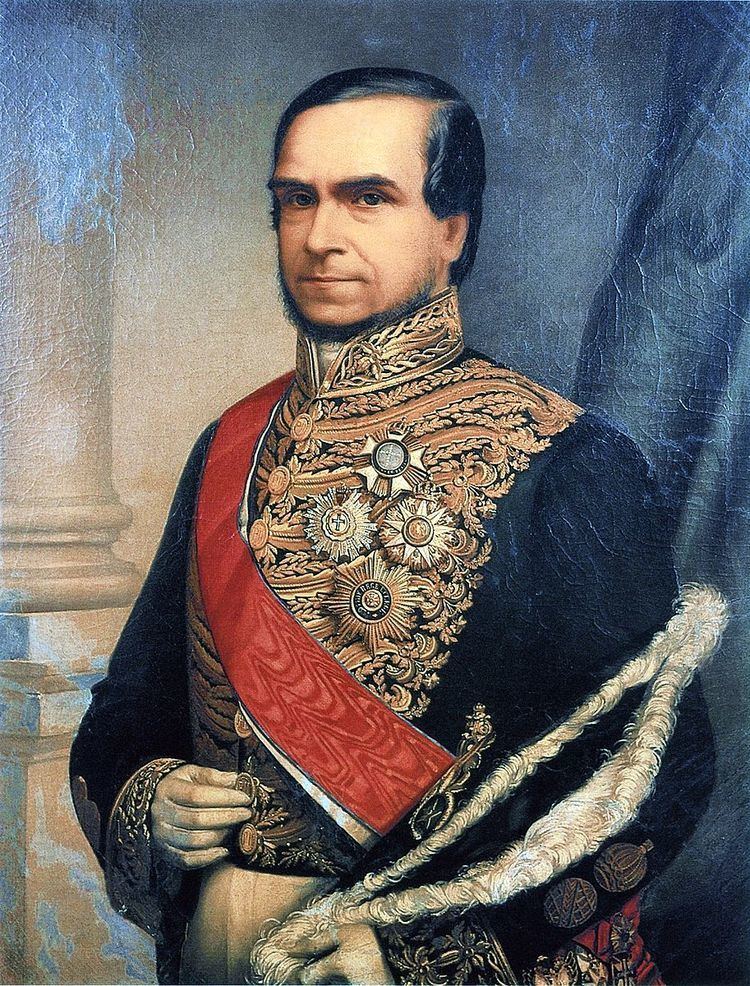 | ||
Brazilian nobility refers to the titled nobles and fidalgo families acknowledged by the Kingdom of Brazil and then by the Empire of Brazil dating back to early 19th century Colonial Brazil with Portuguese noble titles.
Contents
According to the Brazilian Constitution of 1824, the Emperor conferred titles of nobility, which were personal and therefore non-hereditary, unlike the former Portuguese and Luso-Brazilian titles.
After Brazil became a republic in 1889, the new constitution banned the use of noble titles and all titles were abolished.
History
Brazilian nobility originated from the Portuguese nobility, during the time of colonial Brazil. The noble titles were a sign of political power among the elite. Some of the nobles were members of Portuguese noble lineages and even of the high nobility, especially the families that arrived during the first centuries of the colonization of Bahia, Sergipe, Pernambuco, Rio de Janeiro and São Paulo.
The elevation of Brazil to the status of Kingdom, under the United Kingdom of Portugal, Brazil and the Algarves, in 1815, led to the creation of the first Brazilian noble titles. With the Independence of Brazil from Portugal in 1822, the Empire of Brazil established its own nobility. It consisted of the titles of Duke, Marquis, Count, Viscount and Baron. Unlike most systems of nobility, the Brazilian nobility was not hereditary: a title died with its holder.
During the reign of Pedro II, the advent of the commercialization of coffee, it was the great coffee-growers who started to collect such titles, being acquaintances of the coffee barons. According to Affonso de Taunay, around 300 holders had their income linked to coffee: farmers, bankers and traders. The barony ended up being a kind of legitimation of local power, making them intermediaries between the people and the government.
During this period the Brazilian Imperial Family sought to efface republican sentiments with a wide distribution of titles, mainly among important political leaders in the provinces, some aristocrats and also members of provincial oligarchies - were 114 in the year 1888 and 123 in 1889.
Republic
With the proclamation of the First Brazilian Republic, in 1889, the Brazilian nobility was extinguished. It was also prohibited, under penalty of accusation of high treason and the suspension of political rights, to accept noble titles and foreign decorations without the proper permission of the State. In particular, the nobles of greater distinction, by respect and tradition, were allowed to use their titles during the republican regime; a well-known example is the Baron of Rio Branco. The Imperial Family also could not return to the Brazilian soil until 1921, when the Banishment Law was repealed, under the then President Epitácio Pessoa.
The Appointment Process
Noble titles were not hereditary, the candidates could not have in their genealogical tree any of these impediments: bastardy, crime of lese majeste, mechanical trade or infected blood. They were carefully chosen by a set of acts performed and family ancestry. Moreover, most of the winners had to pay a large sum for the nobiliary honor, even if their children perpetuated the titles.
The recipient had ti remit the following fees, in contos de réis, according to the table of April 2, 1860:
In addition to these amounts, there were the following costs:
A list of possible grantees was drawn up by the Council of Ministers, with suggestions from their colleagues, provincial presidents, other nobles, politicians, senior officials, and other influential people. The lists were sent to the approval of the Emperor, being presented, twice a year: December 2, anniversary of the Emperor; March 14 or 25, respectively, anniversary of the Empress and anniversary of the oath of the Constitution of the Brazilian Empire of 1824 - the first Brazilian constitutional charter.
Some Brazilian nobles were given the distinction "with grandeeship," which allowed them to use in their coat of arms the crown of the next higher title - for example, a baron could wear the viscount's coronet on his coat of arms. Also, a Grandee of the Empire enjoyed other privileges and precedence that holders of the next superior title enjoyed. The grandeeship was conferred on 135 barons, who wore the crown of viscount in their coats of arms, and 146 viscounts, who wore the crown of count.
Registration of nobility
The records were made in the books of the then Office of Nobility and Knighthood. In 1848 mysteriously disappeared all the documents of the office mysteriously disappeared in 1848. At the time, they were the responsibility of Possidonio da Fonseca Costa, then King of Arms, which greatly hindered the registration of nobiliary titles granted during the First Reign of the Empire. Luis Aleixo Boulanger, his successor, sought to recover part of this documentation, producing a single book with part of the first generation of the Brazilian nobility.
In all, during the two reigns of the Empire, 1211 titles of nobility were created: 3 ducats, 47 marquisates, 51 counties, 235 viscounties and 875 baronates. The total number of winners, however, was lower - around 980 - as many received more than one title. These numbers are not entirely accurate, as there are doubts about the validity and even the existence of some titles. Much of this doubt is due to the loss of some of the records of the Office of Nobility and Knighthood in the First Reign.
Famous nobles
The only three dukes of the Empire of Brazil were the military Duke of Caxias, the Duke of Santa Cruz and the Duchess of Goiás, respectively brother-in-law and illegitimate daughter of the Emperor.
